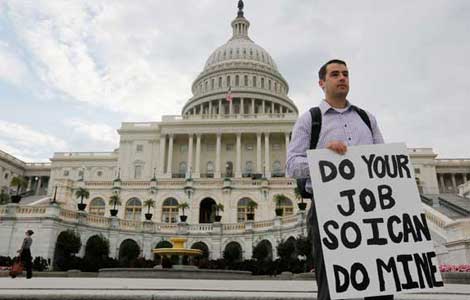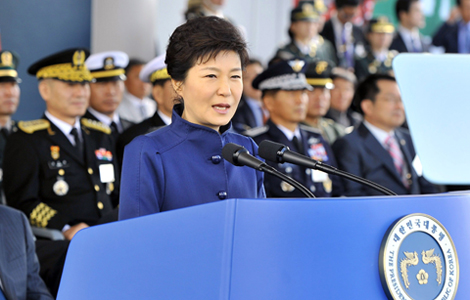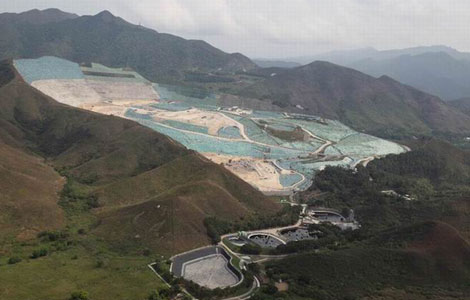US faces tricky problem thanks to QE
Updated: 2013-10-02 13:21
By Stephen S. Roach (China Daily)
|
||||||||
The US Federal Reserve continues to cling to a destabilizing and ineffective strategy. By maintaining its policy of quantitative easing (QE) - which entails monthly purchases of long-term assets worth $85 billion - the Fed is courting an increasingly treacherous endgame at home and abroad.
By now, the global repercussions are clear, falling most acutely on developing economies with large current account deficits - namely, India, Indonesia, Brazil, Turkey and South Africa. These countries benefited the most from QE-induced capital inflows, and they were the first to come under pressure when it looked like the spigot was about to be turned off. When the Fed flinched at its mid-September policy meeting, they enjoyed a sigh-of-relief rally in their currencies and equity markets.
But there is an even more insidious problem brewing on the home front. With its benchmark lending rate zero bound, the Fed has embraced a fundamentally different approach in attempting to guide the US economy. It has shifted its focus from the price of credit to influencing the credit cycle's quantity dimension through the liquidity injections that QE requires. In doing so, the Fed is relying on the "wealth effect" - brought about largely by increasing equity and home prices - as its principal transmission mechanism for stabilization policy. There are serious problems with this approach.
First, wealth effects are statistically small; most studies show that only about 3-5 cents of every dollar of asset appreciation eventually feeds through to higher personal consumption. As a result, outsize gains in asset markets - and the related risks of new bubbles - are needed to make a meaningful difference for the real economy.
Second, wealth effects are maximized when debt service is minimized - that is, when interest expenses do not swallow the capital gains of asset appreciation. That provides the rationale for the Fed's zero-interest-rate policy - but at the obvious cost of discriminating against savers, who lose any semblance of interest income.
Third, and most important, wealth effects are for the wealthy. The Fed should know that better than anyone. After all, it conducts a comprehensive triennial Survey of Consumer Finances, which provides a detailed assessment of the role that wealth and balance sheets play in shaping the behavior of a broad cross section of American consumers.
In 2010, the last year for which SCF data are available, the top 10 percent of the US income distribution had median holdings of some $267,500 in their equity portfolios, nearly 16 times the median holdings of $17,000 for the other 90 percent. Fully 90.6 percent of US families in the highest decile of the income distribution owned stocks - double the 45 percent ownership share of the other 90 percent.
All of this means the wealthiest 10 percent of the US income distribution benefit the most from the Fed's liquidity injections into risky asset markets. And yet, despite the significant increases in asset values traceable to QE over the past several years - residential property as well as financial assets - there has been little to show for it in terms of a wealth-generated recovery in the US economy.
Trapped in the aftermath of a wrenching balance sheet recession, US families remain fixated on deleveraging - paying down debt and rebuilding their income-based savings balances. Progress has been slow and limited on both counts.
Notwithstanding sharp reductions in debt service traceable to the Fed's zero-interest rate subsidy, the stock of debt is still about 116 percent of disposable personal income, well above the 43 percent average in the final three decades of the 20th century. Similarly, the personal savings rate, at 4.25 percent in the first half of 2013, is less than half the 9.3 percent norm over the 1970-99 period.
This underscores yet another of QE's inherent contradictions: its transmission effects are narrow, while the problems it is supposed to address are broad. Wealth effects that benefit a small but extremely affluent slice of the US population have done little to provide meaningful relief for most American families, which remain squeezed by lingering balance sheet problems, weak labor markets and anemic income growth.
The Fed's goal of pushing the unemployment rate down to 6.5 percent is a noble one. But relying on wealth effects targeted at the rich to achieve that goal remains one of the great disconnects in the art and practice of economic policy.
The Occupy Wall Street movement began two years ago this month. While it can be criticized for its failure to develop a specific agenda for action, it galvanized attention to income and wealth inequality in the US and around the world. Unfortunately, the problem has only worsened.
Lost in the angst over inequality is the critical role that central banks have played in exacerbating the problem. Yes, asset markets were initially ecstatic over the Fed's decision this month not to scale back QE. The thrill, however, was lost on Main Street.
That is precisely the point. The Fed's own survey data, which underscore the concentration of wealth at the upper end of the US income distribution, fit the script of the Occupy Wall Street movement to a tee. QE benefits the few who need it the least. That is not exactly a recipe for a broad-based and socially optimal economic recovery.
The author is a faculty member at Yale University and former chairman of Morgan Stanley Asia, and has the book, The Next Asia, to his credit.
Project Syndicate
(China Daily USA 10/02/2013 page11)

 Travel becomes passport to a new look
Travel becomes passport to a new look
 Impasse in Congress shuts down services
Impasse in Congress shuts down services
 Li, Serena cruise on, Venus out at China Open
Li, Serena cruise on, Venus out at China Open
 Portrait of an amateur Waltz dancer
Portrait of an amateur Waltz dancer
 Honoring heroes at Tian'anmen Square
Honoring heroes at Tian'anmen Square
 14 fishermen rescued, 2 dead, 58 missing after typhoon
14 fishermen rescued, 2 dead, 58 missing after typhoon
 ROK urges deterrence against DPRK's nuke threats
ROK urges deterrence against DPRK's nuke threats
 Search for fishermen continues
Search for fishermen continues
Most Viewed
Editor's Picks

|

|

|

|

|

|
Today's Top News
Chinese invest in Vermont
Haier's stake sale a boost
Impasse in Congress shuts down services
US big 3 automakers sales slowdown
Market in antiques booms in Shanghai
Manufacturing shows positive growth
Beijing to issue air quality warnings
China's railways see record traffic
US Weekly

|

|






